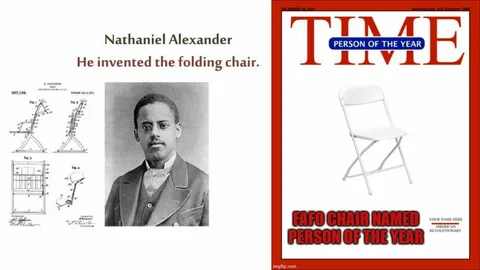The folding chair is an everyday object that we often take for granted, yet its design combines convenience, practicality, and simplicity. But have you ever wondered who invented the folding chair and how it became such an indispensable piece of furniture in our lives? This article will take you on a journey through the history of the folding chair, exploring its origins, various forms, and the inventive minds behind its creation.
The Origins of the Folding Chair

The concept of a folding chair dates back thousands of years. Ancient civilizations recognized the benefits of a chair that could easily be transported and stored. who invented the folding chair were first created for both practical and ceremonial purposes in various cultures. Though it may seem like a modern invention, folding chairs have ancient roots.
Ancient Civilizations and Early Folding Chairs
The earliest known folding chairs can be traced back to ancient Egypt, Greece, and Rome. In Egypt, folding stools were often used by rulers and were seen as symbols of authority. These chairs were made of wood, and sometimes ivory, with ornate designs, signifying the status of the person using them. Similarly, in ancient Greece, folding chairs were used by important figures during ceremonies.
In the Roman Empire, folding chairs were made from wood and metal and were used in both military and religious contexts. The Romans appreciated the practicality of who invented the folding chair for their portability, especially during military campaigns. These chairs could be easily carried by soldiers and set up wherever needed.
While these early versions of folding chairs were reserved for the elite, they laid the groundwork for the development of the more modern and accessible designs we know today.
The Evolution of the Folding Chair in the Middle Ages
During the Middle Ages, who invented the folding chair continued to be used in Europe, particularly by clergy members and royalty. These chairs, often called “curule chairs,” were made with x-shaped frames that allowed them to be folded. The name “curule” comes from the Latin word “curulis,” which referred to a type of ceremonial chair used by Roman magistrates.

Although the folding chair had not yet become a common household item, its use in religious and ceremonial contexts kept the idea of a portable chair alive throughout history. By this time, the folding chair was seen less as a practical object and more as a symbol of power and importance.
The Reinvention of the Folding Chair in the 19th Century
It wasn’t until the 19th century that the who invented the folding chair began to resemble the design we’re familiar with today. The Industrial Revolution brought about advancements in manufacturing and materials, which allowed for mass production and more accessible designs.
The Role of John Cram in Modern Folding Chair Design

One of the most significant contributors to the modern folding chair design was American inventor John Cram. In 1855, Cram was granted a patent for a folding chair that was designed specifically for use in theaters, auditoriums, and public events. His design was simple yet practical, featuring a wooden seat and backrest that could be easily folded and transported.
Cram’s who invented the folding chair became incredibly popular because of its versatility and convenience, paving the way for further innovations in the design of portable seating.
The Contributions of Nathaniel Alexander
While John Cram’s invention was a key development in the history of folding chairs, another inventor made significant contributions as well. In 1911, Nathaniel Alexander, an African-American inventor, patented his own version of a who invented the folding chair. What set Alexander’s design apart was its built-in book rest, making it ideal for church and school settings. This feature added a level of functionality that made the chair more appealing for use in educational and religious institutions.
Alexander’s folding chair was not only practical but also represented a step toward making portable seating more accessible to the general public. His innovation is considered one of the first attempts to combine portability with functionality, something that remains a priority in modern folding chair designs.
The Folding Chair in the 20th Century

As the 20th century progressed, folding chairs continued to evolve and become more widely used. With the rise of modern materials like aluminum and plastic, folding chairs became lighter, more durable, and more affordable.
Fredric Arnold and the Metal Folding Chair
One of the most significant advancements in who invented the folding chair design came in the 1940s when Fredric Arnold, an American inventor, created the first aluminum folding chair with a fabric seat and backrest. This design was groundbreaking because it made the chair even lighter and easier to produce than previous wooden models. Arnold’s folding chair became popular for outdoor events, sporting events, and gatherings.
In the years following World War II, Arnold’s aluminum folding chair became a staple at picnics, concerts, and community events across the United States. The combination of lightweight materials and a durable structure ensured that the folding chair was now an essential part of everyday life.
The Rise of Plastic Folding Chairs

In the 1960s and 1970s, plastic who invented the folding chair began to emerge, offering an even cheaper and more durable alternative to metal and wood designs. These chairs were lightweight, stackable, and easy to clean, making them ideal for a wide variety of uses, from backyard barbecues to large-scale public events.
Plastic folding chairs quickly became the go-to choice for event organizers due to their low cost and practicality. The introduction of injection-molded plastic allowed for mass production at a scale previously unseen, ensuring that folding chairs could be found in homes, schools, offices, and public spaces worldwide.
Modern Folding Chair Designs
Today, folding chairs come in a vast array of designs, materials, and colors. From sleek metal designs for office spaces to lightweight plastic models for outdoor use, the who invented the folding chair has become one of the most versatile pieces of furniture.
Innovative Folding Chairs for Different Purposes
In recent years, folding chair designs have become even more specialized, with models designed specifically for different environments. For example, folding chairs for camping are often made with durable materials like canvas and aluminum, providing comfort and stability in outdoor conditions. There are also ergonomic folding chairs designed for offices, which offer better lumbar support for long hours of sitting.

Some modern who invented the folding chair even feature advanced technology, such as built-in heating elements or adjustable heights, catering to niche markets and consumer demands. These innovations demonstrate that the folding chair continues to evolve, adapting to new uses and environments.
The Cultural Impact of the Folding Chair
Beyond its practical uses, the folding chair has also made its mark in popular culture. Whether it’s a symbol of community gatherings or a prop in professional wrestling, the folding chair holds a unique place in our collective consciousness.
The Folding Chair in Pop Culture
Perhaps one of the most famous uses of the folding chair in popular culture is its association with professional wrestling. In wrestling matches, the who invented the folding chair is often used as a weapon, adding drama and excitement to the event. This pop culture connection has turned the folding chair into more than just a piece of furniture—it’s now a symbol of action and spectacle.
In addition, who invented the folding chair have been used in art, film, and literature as symbols of simplicity, mobility, and practicality. Their presence at concerts, rallies, and political events further cements their role as an essential part of everyday life.
Conclusion
The invention of the folding chair is not attributed to one single person but rather a series of innovations that span centuries. From ancient Egypt to modern-day designs, the folding chair has evolved into a versatile and essential piece of furniture. Whether it’s the innovations of John Cram, Nathaniel Alexander, or Fredric Arnold, the who invented the folding chair has a rich history of ingenuity and practicality.
As we continue to seek convenience and efficiency in our everyday lives, it’s likely that the folding chair will remain a fixture in homes, offices, and public spaces for years to come.
















Leave a Reply